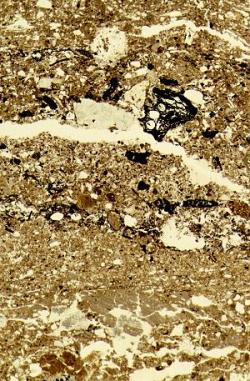Micromorphology
Wendy MatthewsIn this exciting time of interdisciplinary analysis of material from five years of excavation, microscopic study of sequences of floors and deposits is contributing to identification of small and large scale changes in uses and concepts of space, as well as micro-environment, in the life-history of buildings and their inhabitants.
In all of the buildings at Çatalhöyük a range of different zones/spatial conventions have been identified by the character of the plasters or surfaces selected, the impact of activities on those surfaces, the type and thickness of accumulated micro-residues, as well as the post-depositional alterations. In Building 1 there are clear differences between the trampled mud plaster floors and comparatively thick accumulations of plant remains, organic staining and burnt aggregates in food preparation and cooking areas (Figure 25) and the layers of fine white plaster laid on top of the burial platforms. Other variations include traces of water/liquid splashed next to the basin in Space 70; thick packing in storage areas; and unusual highly organic deposits in the NE corner. Microscopic studies are also contributing to studies of human burial, and closure of graves. |
 Figure 25: Accumulated deposits adjacent to a hearth. these include fragmntns of charred oak wood (centre right) mixed with trample from underlying mud plaster floors. Frame height = 11 mm |
In Building 5 the surface of a probable storage area in Space 156 was covered in disturbed aggregates and was not very well maintained. Impressions of decayed and siliceous plant remains have been identified in front of the storage bins in Space 157, and will be analysed in greater detail in collaboration with Dr Arlene Rosen. As in Building 1, the SW platform was generally coated in mud-plaster and had traces of food preparation and cooking residues. This is in contrast to the NW and E platforms, which were coated in multiple layers of white plaster. The NE corner, like that in Building 1, had repeated accumulations of highly organic deposits which are currently being analysed to identify the siliceous plant remains and any traces of organic residues. These organic deposits were present throughout the narrow room Space 155, which was coated in a distinctive thick red mud plaster.
Dung was a major source of fuel, both in these buildings, and during the earliest occupation at the site. Its abundance has implications for human-animal inter-relationships and early agriculture. Animal pens have been identified within the South Area of the settlement in Levels XII-XI, and X/VIII. Wood and grasses were also used as fuel, sometimes on separate occasions, and may have had different ecological or socio-cultural associations.
During this year痴 excavation 10 thin section samples were collected by Anne Marie Vandendriessche from the BACH1 Area and 2 from possible floors/surfaces in buildings on the West Mound.